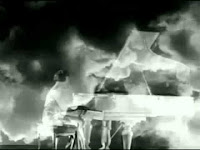Louis Buñuel & Salvador Dalí, Un Chien
Andalou, 1929 (16 min)
Many people mention the eye-slicing scene,
so this is my mention, but I was more interested in the time aspect. It starts
“Once upon a time” to suggest a fable or other similar story, and then jumps
around to ‘8 years later’, ‘16 years ago’ and a present time ‘around 3 in the
morning’. The time changes, but
the characters did not seem to change a whole lot. Then there was the box,
which the severed hand was put into. At the end on the beach the box was
smashed and I do not recall seeing the hand. Would this be the “hand of time”?
Man Ray, Le Retour à la Raison (The Return to Reason), 1923 (2 min)
I was most interested in the rayograms
(sometimes called rayographs), the sections where there were noticeable objects
appearing as silhouettes. Another point of interest was the stop-motion
animation of the tack, spinning in the same spot. The precision of getting the
tack in just the right place, all while making it turn was amazing (unless I
find out later that Man Ray created this differently). I found the use of multiple
exposures visually interesting, even if appeared to be the inside of an older
model of ice cube tray being spun; the cast shadow saved the scene.
Man Ray, L’Étoile de Mer (The Starfish),
1928 (15 min)
The seemingly underwater effect/blurred
filter made me think I was watching this film from the perspective of the starfish
in the jar, until there were scenes without this effect. Seeing the effect then
not the effect, the woman behind the newspaper, the 12 frames in 1 frame made
me think of the art of revealing something, as though there was something
purposely being hidden. Then the mirror, reflecting the woman with shots
relating to beauty, is smashed.
Fernand Léger and Dudley Murphy, Ballet Mécanique, 1924 (11 min)
I tried to relate this film to the (very)
little I know about ballet. I saw the repetition of the woman swinging and the
woman walking up the stairs like a dancer twirling across the stage. The
kaleidoscope effect on the people and the moving machines perhaps suggested a
similar type multi-faceted nature between the human and the machine. The
dangling reflective sphere was jarring as it swung toward and away from the
lens.
Marcel Duchamp, Anémic Cinéma, 1926 (6 min)
I have had the most trouble watching this
film. This was the second or third time seeing this and I still got a bad case
of motion sickness (no matter how far away from the screen I sit). I do not
know what was worse the twirling spirals or the spinning French text. The text
seemed to be random bits of information, some ads, some questions.
Sergey Eisenstein & Grigory Alexandrov, Romance
Sentimentale (Sentimental Romance),
1930 (16 min)
The repetition of the ocean crashing, the
clouds and the trees almost in time to the music, especially the swells in the
music was more interesting than the woman singing. I was kind of bored with the
middle. I got the idea she was sad by her body language and black dress, but I
have no idea what she was actually saying. The use of the clock suggested this
sadness lasted for some time or as the end played out it was only a matter of
time before this sorrow was over. With the rain scene followed by the sun
traversing the sky, the flowering trees, the woman now in a white dress,
smiling, suggested the rain washed the sorrow and a new life or better days are
to follow.
Henri Chomette, Cinque Minutes de Cinéma Pur (Five
Minutes of Pure Cinema), 1926 (5 min)
The reference to the title about “pure
cinema” lead me to think about what it means to film an object. In order to see
anything, capture anything on film there needs to be a light source. These glass
or reflective objects arranged with light bouncing off them, spinning or
dissolved into new formations of a dazzling light show, albeit a bit boring.
Then the transitioning section of trees seemed to echo sections from the
earlier part of the film, but in reverse; the reflective gleaming objects on a
black background and the darkness of the trees on the blown out sky or water.
René Clair, Entr’acte, 1924 (20 min)
[Note: Images either Googled or created by screenshots]








I agree with your view on Sergey Eisenstein film, "Romance Sentimentale", and how the middle was kind of boring. Although I would have to disagree with you that the "swells in the music was more interesting than the woman singing". I believe they were equally interesting. The woman singing added a lot of tone and depth to the film. Even though we do not know what she is singing about, her tone adds a personification to the film.
ReplyDelete